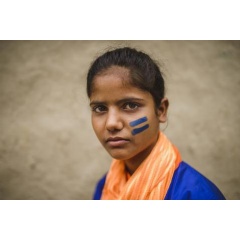150 Million Girls Are at Risk of Child Marriage by 2030: The Time to Act Is Now
New study sounds an alarm, urges swift action in South and South-East Asia.
“We need to accelerate our efforts to end child, forced, and early marriage and to address the drivers of adolescent pregnancy” said Bjorn Andersson, UNFPA Regional Director for Asia and the Pacific.
Even though initiatives to end child marriage are showing results in South and Southeast Asia, these efforts must be urgently scaled up to protect 150 million girls at risk of child marriage by 2030.
That’s the key message in the new regional study launched by Plan International with the support of UNFPA, the UN’s sexual and reproductive health agency.
“Time to Act: Accelerating Efforts to Eliminate Child, Early and Forced Marriage in Asia” details effective interventions and initiatives that will help achieve the global ambition to end child, early and
forced marriage under the wider umbrella of the 2030 Agenda for Sustainable Development.
Youth advocates from across Asia gathered in Bangkok to help launch the study alongside key influencers including high level diplomats, UN agencies, the Committee on the Rights of the Child, the ASEAN Secretariat, international NGOs, lawmakers and regional think-tanks.
The youth advocates shared diverse experiences on how they have opposed child marriage, while expressing their demands for future generations of children and young persons.
Child marriage in South and Southeast AsiaSouth and Southeast Asia continue to have significant levels of child, early and forced marriage. Bangladesh is among the world’s highest with 52% of girls married by the age of 15, while in Cambodia 19% of girls are married or in union by the same age. Adolescent and teenage pregnancies are also rising in Asia, with 43% of such pregnancies unintended, some occurring within marriage.
Unintended adolescent pregnancies also fuel high rates of abortion in the region, much of it unsafe.
“We need to accelerate our efforts to end child, forced, and early marriage and to address the drivers of adolescent pregnancy” said Bjorn Andersson, UNFPA Regional Director for Asia and the
Pacific. “Achieving zero gender-based violence and harmful practices such as child marriage is one of UNFPA’s Transformative Results. We can do this by strengthening measures to protect and
empower young girls, and by working together with all of society to address the root causes of child marriage, including gender inequality, vulnerability and poverty.”
Deep-rooted social norms around roles and values ascribed to girls contribute to early marriage while economic and systemic circumstances that drive families to force children to marry persist. This undermines the integral health and wellbeing of girls, exposing them to violence, unwanted pregnancy and limiting their education and employment opportunities. The harmful practice is restricting the economic and social development of whole nations.
“Child, early and forced marriage is a harmful practice impacting the economic and social development of nations at large. With this report, we call for increased investments and accelerated action to ensure child marriage is a problem of the past,” said Bhagyashri Dengle, Interim Regional Director of Plan International Asia. ”It is a critical time to capitalize on the progress made, and step up the gains to ensure no girl is left behind.”
Evidence-based steps include youth-led advocacy, comprehensive sexuality and health education, engagement of men and boys and empowerment of girls to ensure their choices are respected, listened to and valued. Political will and enforced legislation are particularly critical to prevent child, early and forced marriage and support young people to have the freedom to choose as adults, if and when to marry and to whom.
Globally, 12 million girls marry before the age of 18 each year. If sustainable action isn’t taken now, more than 150 million girls will become child brides by 2030.
( Press Release Image: https://photos.webwire.com/prmedia/5/234228/234228-1.jpg )
WebWireID234228
This news content was configured by WebWire editorial staff. Linking is permitted.
News Release Distribution and Press Release Distribution Services Provided by WebWire.
